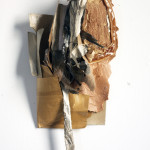The artwork of Gillian Tobin is anything but obvious. It takes time to see, observe, study, and digest her intent and message…patience and curiosity are required. These are exactly the qualities that attracted me to her work. I didn’t “get it”…but desperately wanted to.

Gillian is a graduate of Kansas City Art Institute (KCAI) earning her Bachelor of Fine Arts in Painting and Art History. She went on to receive a Master of Arts from Eastern Illinois University and most recently a Master of Fine Arts from Washington University’s (St. Louis, MO) Sam Fox School of Design and Visual Arts. Currently residing in Kansas City, MO, Tobin will spend the next year juggling a couple of part-time jobs while she concentrates on creating new work during her residency at Charlotte Street Foundation’s Urban Culture Project. This program provides free studio space for a year to around thirty visual and performing artists as well as writers. Studios are located in previously vacant upper floors of office buildings downtown. Components include annual open studios, exhibition and performance opportunities at Charlotte Street’s nearby Paragraph gallery & Project Space, monthly all-resident group meetings with artist presentations, studio visits, and mentorships.
Gillian is a sculptor that uses found materials, personal souvenirs, and paint to create artwork that draws inspiration from her own life experience. Her work is extremely personal, feeding off a full range and complexity of personal feelings and emotions. She creates her sculptures out of what she calls “paint skins.” This substance is a mixture of acrylic mediums, marble dust, coffee grounds, gap filler, concrete, rubber latex, and several other materials. She pours the mixture onto plastic, allows it to dry, and then peels it up to use as the prominent medium in her work. The creations that surface are physical manifestations of complex emotions, thoughts, concepts, and recollections. Her work is uncanny, abstract…yet eerily familiar…begging you to stay a while and understand.
Read on to learn more about Gillian her artwork…
Emily Frankoski: Where are you from originally and where do you now reside?
 Gillian Tobin: I was born and raised in St. Joseph, Missouri. When I finished high school, I moved to Kansas City to attend the Kansas City Art Institute. I received my BFA (painting and art history) in 2009. In 2011, I moved to Charleston, IL to attend a one-year Master of Arts program at Eastern Illinois University. Once I finished my MA in May 2012, I moved to St. Louis, MO to start the Master of Fine Arts program at Washington University in St. Louis Sam Fox School of Design and Visual Arts. I graduated with my MFA in May 2014 and moved back to Kansas City where I currently reside.
Gillian Tobin: I was born and raised in St. Joseph, Missouri. When I finished high school, I moved to Kansas City to attend the Kansas City Art Institute. I received my BFA (painting and art history) in 2009. In 2011, I moved to Charleston, IL to attend a one-year Master of Arts program at Eastern Illinois University. Once I finished my MA in May 2012, I moved to St. Louis, MO to start the Master of Fine Arts program at Washington University in St. Louis Sam Fox School of Design and Visual Arts. I graduated with my MFA in May 2014 and moved back to Kansas City where I currently reside.
EF: What did you want to be when you grew up? How does that compare to what you are living out in your adult life? Has your journey been linear or non-linear?
GT: I always wanted to be an artist. As a child I spent most of my time drawing. My mom always says I’ve been drawing since I was old enough to sit at a table. I am a practicing artist, although I think as a child I definitely romanticized the notion of being an artist. For “Career Day” in elementary school I wore a beret, a paint splattered shirt and carried around a wooden palette. So, perhaps a bit naïve and romantic. I think my journey has been pretty linear. I knew I wanted to go to an art school for college when I was a freshman in high school. During that time I took several continuing education classes at the Kansas City Art Institute including a portfolio preparation class. I was introduced to training in figure drawing and drawing from perception at those classes.

I applied to KCAI and two other art colleges. I got into all three, but I decided on KCAI because of the great relationships I had already built through their continuing education classes. During my time at KCAI, I always knew graduate school would be the next step.
This is where the path becomes a bit non–linear. I was jaded and burnt out after finishing college. I didn’t really make any work for about a year and a half. I worked two jobs and tried to take a GRE prep-class. I thought I might go to graduate school for art history since I couldn’t seem to make any work. I worked my two jobs and went to prep-class, sometimes for 12 or 14 hours a day. I was miserable. In the spring of 2011, I heard about the Master of Arts program at Eastern Illinois University through a friend who had attended. The program can be viewed as an MFA preparation year – to build your portfolio of work and interests. I was accepted with a full tuition waiver and $800 a month stipend to teach twice a week. While I was there, I applied to multiple MFA programs and decided on Washington University in St. Louis.
I guess I never really planned for after the MFA. I didn’t expect to be back in Kansas City, but I’m not upset about it. It’s a great city for the arts.
EF: What were you like as a kid? Were you a good student? How did you choose to spend your free time?
GT: I was a good student. I got all A’s and B’s for the most part. I was also the type of student who spent the majority of class-time doodling. As a kid, I spent a lot of my free time drawing or reading. I’d say I was a pretty sensitive kid and I still am. In high school I attended a lot of concerts. I still spent my free time drawing, reading, and listening to music. It was during this time I began taking additional art classes at Missouri Western State University in St. Joseph as well the Kansas City Art Institute.
EF: How did your relationship with art begin? What is your background in art?
GT: My relationship with art began with drawing – plain old #2 pencil on white printer paper. The house I grew up in had a long white Formica bar with stools. Everyday I sat there drawing “stories.” I think this stemmed from both my love of cartoons and my mother reading to me and my sister every night. I liked to attempt to recreate characters from illustrations and TV shows.


During my undergraduate studies, I started out making heavily textured, chunky, abstract landscape oil paintings – basically Anselm Kiefer rip-offs. Then at the beginning of my junior year, my professor asked me why I was painting. Initially I was baffled by the question, but as I transitioned away from the canvas, my work really started to develop its own personal, authentic language during my junior and senior year. As my work became more object based, I learned the importance of experimental processes, as well as the failures, surprises, and rewards that happen when contingency plays a role.
From that time forward, I have had an increasing interest in object making. However, most of my work is still heavily related to painting. I go back and forth between 2D and 3D.
EF: Is art your full-time “career”?
GT: I’m trying to make it my career but for now, working as a studio assistant and waiting tables, pay the bills. I still sell drawings and smaller works sporadically.
EF: What are your struggles in being an artist?
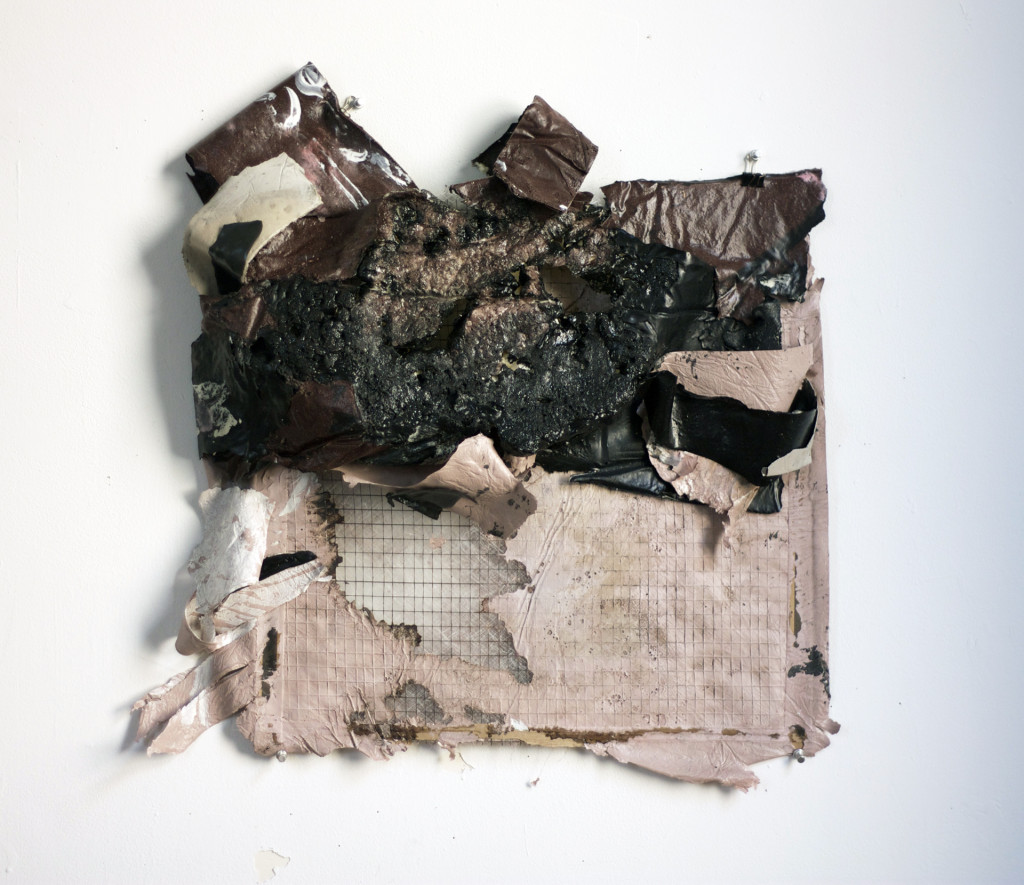 GT: There are so many struggles. There are very few things about it I would call easy. Aside from obvious financial restrictions, I find my thoughts are never too far away from my studio practice, which can be overwhelming and guilt producing.
GT: There are so many struggles. There are very few things about it I would call easy. Aside from obvious financial restrictions, I find my thoughts are never too far away from my studio practice, which can be overwhelming and guilt producing.
As an artist, you’re always wondering if you’re wasting your time, if you’re actually any good, if this “art thing” will ever pay off. We constantly seek out new opportunities – jobs, residencies, shows. There is always the possibility of rejection. I feel pretty demoralized a lot of the time. I like to make my work, but there are many things about the art world I find contrived and frustrating. I’m not ashamed to admit I’m sensitive and easily become complacent and discouraged. It’s a challenge right now to maintain any semblance of a regular studio practice. I accepted long ago that I wouldn’t be able to pay the bills with my work.
EF: What would you call your prominent medium and how would you explain it to a novice?
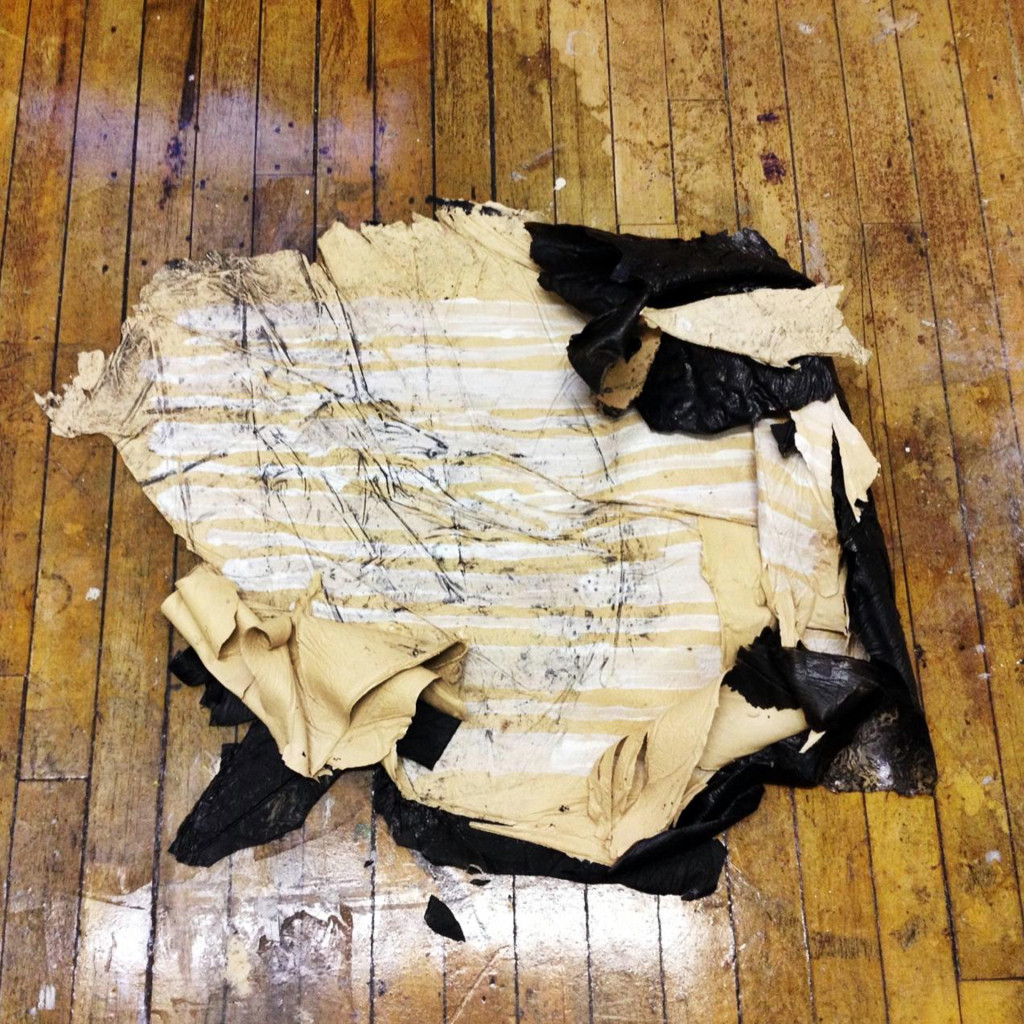
GT: I’m a sculptor. I use found materials, personal souvenirs, and paint. My sculptures are primarily made out of paint skins. I mix acrylic mediums, marble dust, coffee grounds, gap filler, concrete, rubber latex, and several other materials together, pour the mixture out on plastic, allow it to dry, and then peel it up to use in my work.
EF: How would you describe your artwork in 4 words or less?
GT: Uncanny yet sensitive things.
EF: In your opinion, why is what you do important? Why do you create what you do?
GT: I know that what I do is important to me. My work is very personal. It’s a part of me. It’s a part of what makes me feel normal. The things I make are an attempt to get at some un-nameable feeling – to make solid fleeting feelings that reject being categorized.
EF: What would you be if you weren’t an artist?
GT: I toyed with the idea of being a writer or an art historian for a while. I still do consider myself a writer, and writing is critical to my studio practice.
CURRENT & FUTURE PROJECTS
EF: Tell us a little about your current residency through the Charlotte Street Foundation’s Urban Culture Project. When did you begin it and when does it end?
GT: Charlotte Street Foundation’s Urban Culture Project provides free studio space for a year to around thirty visual and performing artists as well as writers. Studios are located in previously vacant upper floors of office buildings in downtown Kansas City. Components include annual open studios, exhibition and performance opportunities at Charlotte Street’s nearby Paragraph gallery & Project Space, monthly all-resident group meetings with artist presentations, studio visits, and mentorships. I’ll be a resident artist until September 2015. You can find more information, including images of other residents’ work at this link: https://charlottestreetstudios.wordpress.com/

EF: What do you hope to accomplish throughout this residency? Is there a project or goal that you have in mind? If so, explain.
GT: I want to take full advantage of the opportunities and studio space I’ve been granted. My goal is to find a way to make a sustainable art practice – to make a new body of work and hopefully start showing more.
EF: Do you create constantly, or have another gig on the side?
GT: I wish I could create constantly. During graduate school I realize how lucky I had it. Everyday, I woke up, went to my studio, stayed there until exhaustion set in, and then I went home only to repeat the same schedule the following day. That’s what it’s like to be a full time artist. Unfortunately, I work quite a bit during the day as a server at Genessee Royale Bistro in the West Bottoms, and for a couple of artists that have studios in the Crossroads Arts District. Scheduling studio hours has been tricky, as I prefer to work during the day.
EF: What is next for you after this residency?
GT: I don’t know yet. I’m consistently applying to residencies nationally and internationally as well as jobs. Hopefully something works out.
PROCESS & PRACTICE
EF: To gain perspective, what are the dimensions of your sculptures?
GT: My sculptures range in size from small table-top works to wall reliefs that are 3’x2’x2’ to large material studies on canvas sized 6’x4’. Scale is something I’m constantly wrestling with in my work. You gain some thing when scaling up but you can also lose the intimate, personal quality that a smaller work conveys.
EF: What are the stories you like to tell in your artwork? What are your inspirations? Can any common themes be found?
GT: I draw inspiration from my own life – my experiences and more precisely the range and complexity of feelings and emotions that can manifest. However, that is not the content of my work. I’m interested in aesthetics and metaphysics – what does longing actually feel like – what would it look like if it had mass and solid contours. What does home really mean? We often associate it with physical space when its poignancy derives more from feelings of belonging. How can I visually connote domestic space without illustrating? How do I illuminate the fragment as both a physical and emblematic entity? I am interested in the symbolic and metaphoric connotations that arise from domestic fragments – a window frame, an old journal, strips of wallpaper, or a lone dresser drawer. The visual language of my work is abstract and semblant. Shapes and colors allude to those found in a domestic setting without being specific. So while the work is very personal, it is also archetypal.
Invested in the ontology of objects, I create elastic, layered skins that are ultimately uncanny. Abstract yet familiar, they resemble remnants of walls, wounded membranes; hiding domestic debris such as journal spines, silenced pages, wire grating, decorative patterns, and architectural ornamentation. They expose themselves and then retreat and retract, folding into insecure, sagging postures, concealing their selves while revealing their pliability as objects. Physical embodiments of defeat, grief, loss, and self-preservation: states of being that are ephemeral and transient made concretized. Giving solid contours to the passing feelings that refute definition. Fragmentary states – they are the everyday experience of the impossible. Folds and creases imply the shift of weight under gravity, but the fragments remain still. The materiality of events has escaped these objects, yet they remain.
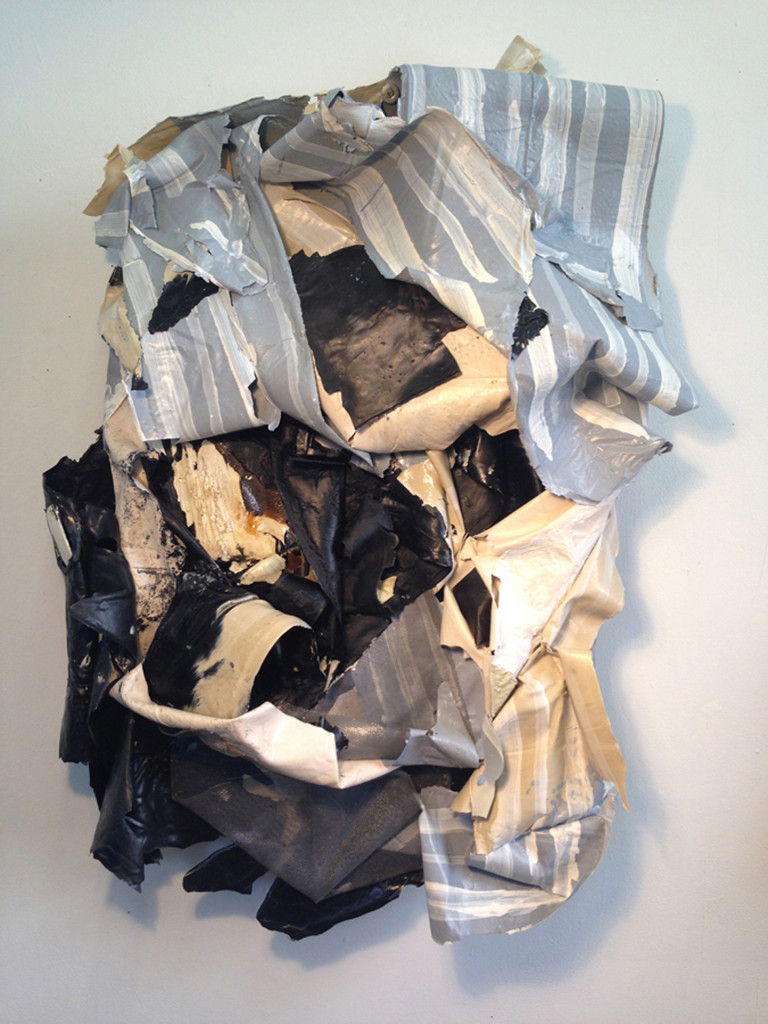
My works loosely allude to spaces in the house while still denying specificity. They indicate a world past matter and delineation, suspended in between physical reality and somewhere else. The relief like quality indicates that they are not from the wall nor are they on the wall. Yet they fail to entirely enter our physical space. They float in between, removed from gravity, maintaining distance. Their shadows carve out a space separate from the physicality of the wall, phantasmal silhouettes. Materials and forms reference both private and public portions of the house, disjointed remembrances of material parts associated with some notion of “home.” Their rough edges and bodily folds dismantle our initial nostalgic recollections.
Strange and a bit ugly, they quietly long for empathy. Reserved with pocketed interiors like the closed off spaces within a house, they deny deterioration or mending, contently dwelling in a moment of grief. Mutely testifying to the passage of time, while still remaining detached from it, mysterious in their unexpected duration and corrosion. They are about form and feeling.

EF: Describe the evolution of your artwork – adolescence, to undergrad, to graduate school, to now/real world – how has your artwork changed over time?
GT: It’s matured quite a bit, and I feel more comfortable with taking risks both conceptually and materially. My interests in philosophy and poetics have broadened and inform my work more than ever. Earlier work always felt staged and theatrical. I think my more recent works still appear very composed, yet more authentic and original to me as their author.
EF: Walk us through your creative process. How do you get from point A to finished product? How long does one piece of artwork usually take you?
GT: Making is a singular activity. It requires patience and trust in the uneasy nature of experimentation. My work has always been driven by the surprises and failures that occur in the evolution of a process, and subsequently an arduous effort to control or exhaust that process. My studio practice embraces the awkward and eccentric paths a creative practice travels. With a background in painting, I remain fascinated by the potential transformation of materials, the alchemical exchanges that occur when order is relinquished to chance. I strive to recreate and manipulate the happy accidents that occur during the investigation of material possibilities. However, the hand contending with abstraction is present throughout. A gestural brush stroke both connotes domestic space while refuting it. The performative actions of the fabrication process are tied directly to content: embedding objects and their importance, transferring traces of patterns and unknown debris – folding, layering, peeling, and wrapping.
I can make a piece in a single day or sometimes it takes several weeks or up to a month.
 EF: Could you explain a few works for me? I really love the piece consisting of a billion wrapped packages – what was your inspiration and intent? Could you do the same for your most recent work on your tumblr page?
EF: Could you explain a few works for me? I really love the piece consisting of a billion wrapped packages – what was your inspiration and intent? Could you do the same for your most recent work on your tumblr page?
GT: That work was made during my time at Eastern Illinois University (2011-12). I was experimenting with installation and had become interested in ideas of inaccessibility in relation to the domestic sphere. They were supposed to connote wrapped books. Concealing, covering, costuming, and hiding have been themes that consistently reappear in my work. The book form is also a reference I continually work with, mainly because I don’t yet understand all its implications.
The latest work on my tumblr page, A.M.’s Spine was inspired by my roommate and friend. She gave me this beautiful photography book that was water damaged and I deconstructed it down to the book spine, pages, and front and back cover. I’m not sure how to talk about it yet because I don’t think it’s resolved. I think something has to happen with the remains of the gutted book. However, the book form constantly intrigues me. It can be seen as wholeness and knowledge, yet in my work it is always unreadable. It also has bodily connotations and interesting tensions between inside and outside. It is surprisingly, easily abstracted.



THIS & THAT – GENERAL Q’S
EF: What have reactions been towards your artwork? Do the reactions please you?
GT: The most recent one came from a dear friend/mentor, Tanya Hartman – an excellent artist. “You’re work is really emotional and sensitive. It’s beautiful, but it’s weird as hell. People aren’t going to get it.”
I think she nailed it. I know it’s weird. I’m interested in the uncanny: the sensation that something is simultaneously familiar yet strange and unsettling.

EF: What have you learned about yourself through your artwork?
GT: I’ve learned a lot about what moves me, what art means for me. I’ve also learned “making” is just something I will always do, regardless of what may or may not happen in the future.
EF: Do you work on one project at a time until finished – OR – do you work on multiple projects simultaneously?
GT: I always try to have a couple of pots on the stove. Since I work with paint and other fluid materials, drying times can take several days to a full week. I’m always conducting little experiments on the side too.
EF: Do you ever have the artist equivalent of “writers block?” How do you get past this so you can keep/finish creating?
GT: All the time. I’m sort of experiencing it right now. I guess the best thing is to just show up. Just get to the studio even if it’s only for a few hours. It’s difficult but you have to remind yourself that creativity, just like everything else, ebbs and flows.
EF: When you are not creating, what might one find you doing?
GT: Working, working, working. Or hanging out with my new dog, Felix!
EF: If you had to pick one piece of your work to represent yourself as an artist, which would it be and why?
GT: I don’t think I can do that yet. My work has changed and matured so much over the past 2 years, and I can only hope it will continue to get better.

EF: For whom do you create? Who is your audience?
GT: After seven years of academia, I’m trying to create just to create…mostly for myself but I’m also always considering my fellow artist friends and family. It’s refreshing as well as anxiety producing to create without deadlines or constant feedback from professors.
EF: What do you want people to understand/take away from viewing your work?
GT: People can take away whatever they want from the work. It’s abstract and I think that’s where the beauty resides. There is no right or wrong answer, theme, or perspective to take away. Abstract work allows you to make your own assumptions.
EF: How do you promote your work? Do you seek out opportunities or do they come to you?
GT: I seek out opportunities as far as jobs and residencies are concerned. I’ve been trying to promote myself more publicly through tumblr and other social media (Facebook, Instagram). I am a bit shy about applying for exhibitions and shows, which is something I need to work on. It’s always nice when people come to you with opportunities though.

EF: How do you continue to challenge yourself and grow as an artist?
GT: I think I am consistently unsatisfied. Intrinsic to my personality is a desire to continually improve and progress. After committing most of my young adult life to an extensive education in the arts, I have an internal responsibility to continue that journey.
EF: Do you sell your artwork? If so, where can we buy it?
GT: I do! Inquiries can be emailed to gillianmarietobin@gmail.com. I’m open to doing commissions too.

EF: To date, what project has given you most satisfaction?
GT: I suppose finishing my MFA. Although I can’t say it was complete satisfaction. I was proud of the work I did. Since it was a group show, in a museum, space was limited. I wasn’t able to show everything I had planned for in the exhibition. After two years of incessant high stress and hard work – the feeling of satisfaction was there but somewhat stifled by relief and remorse.
EF: What artists do you admire and why?
GT: There are so many. I love work that is emotional yet challenging, smart and enigmatic in presence. Eva Hesse is my all time favorite. I owe a lot of my thoughts, material choices, forms, and also an embracement of experimental process to her. My work is definitely influenced by her and a lot of post–minimalist thought. I also really love Felix Gonzalez-Torres, Philip Guston, Doris Salcedo, Sarah Sze, Tacita Dean, Cornelia Parker, Sophie Calle, Robert Gober, and Gordon Matta-Clark.
EF: Do you have a favorite piece of art (other than your own)?
GT: I have a couple, but there is this really amazing piece by Eva Hesse at The Art Institute of Chicago. It’s called Hang Up. It’s so strange and a bit intrusive yet delicate and emotional. I like work that is paradoxical – able to make dichotomies seem natural. Seeing it physically is an entirely different experience than viewing the piece in photographs.
EF: What is the best piece of advice you have ever received?
GT: Don’t compare yourself to others.
EF: What is your favorite book?
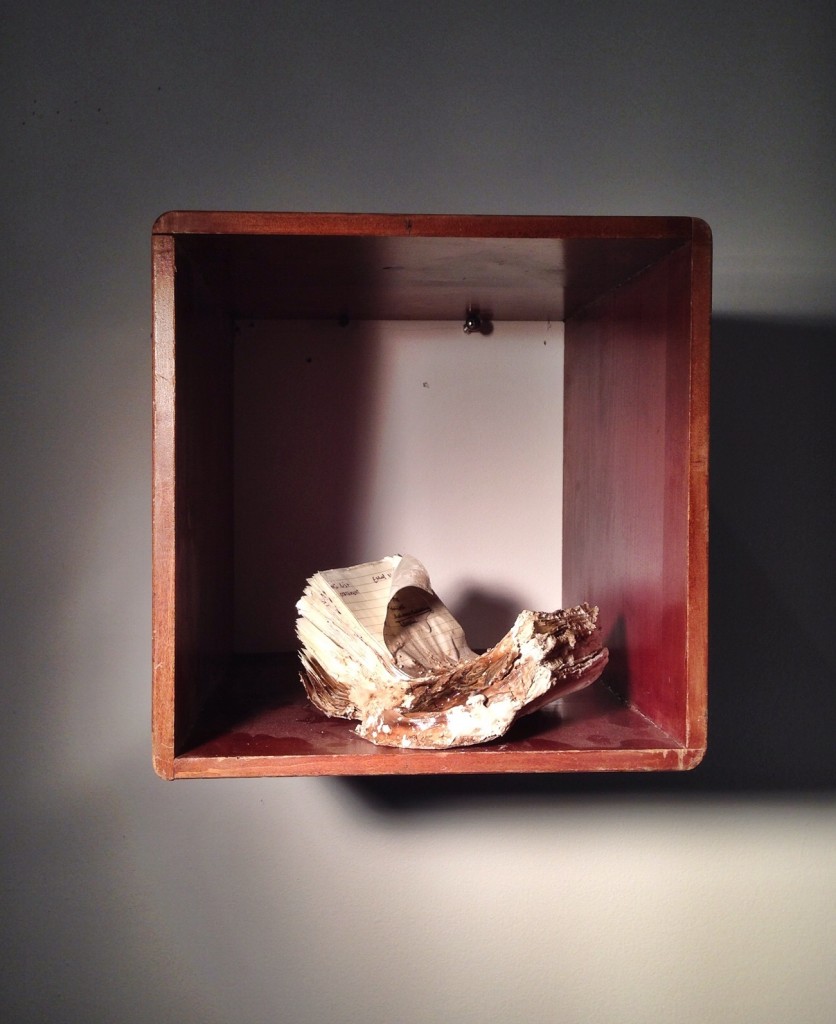
GT: My favorite book is The Poisonwood Bible by Barbara Kingsolver. Other favorites include Franny and Zooey by J.D. Salinger, Middlesex by Jeffrey Euginides, Interruptions by Hans-Jost Frey, and Ordinary Affects by Kathleen Stewart.
EF: What are you currently reading?
GT: I’m not going to lie; I’m not reading anything at all right now, which is rare for me. Like I said, I am easily ailed by complacency. I even got a library card and reserved books, yet I’ve failed to pick them up over the last week.
EF: Do you have a favorite quote?
GT: I have quite a few because my mom is always sending me inspirational quotes, but this one seems most appropriate for this interview. It’s from Eva Hesse.
“I am interested in solving an unknown factor of art and an unknown factor of life. In fact, my idea is to counteract everything I’ve ever learned or been taught about those things – to find something that is inevitable that is my life, my feeling, my thoughts.”
EF: Where can we see more?
GT: I’m trying to post regularly on my tumblr page (gilliantobin.tumblr.com) and you can find my work on instagram – user name: gmtobin.
LINKS
- gilliantobin.tumblr.com
- http://gilliantobin.blogspot.com
- https://charlottestreetstudios.wordpress.com/current-residents/gillian-tobin/
- http://artoftang.com/jose-garza-on-gillian-tobin/
- http://make-space.net/2011/12/01/gillian-tobin/
- http://make-space.net/2012/02/29/patternbase-discussions-gillian-tobin/


